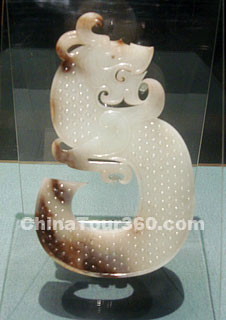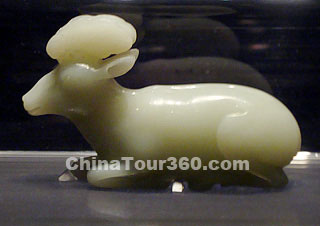![]() Pre-historic Period: the Era of Jade Wares?
Pre-historic Period: the Era of Jade Wares?
A great many Jade-ware objects have been found dating from the Neolithic ear, the period of 4,000 years prior to the establishment of Xia Dynasty (21st-17th century BC). The craftsmanship achieved its first pinnacle. Raw materials were obtained from local sources and this led to a wide variety and diversity of styles and appearances. In general, tremolite and serpentite jade formed the bulk of the raw materials used. Other 'beautiful stones' such as quartz and agate were also part of the material supply. This explains why the ancient people paid attention to the hardness, color and luster and it also demonstrates that they drew few lines of distinction in their choice of materials, which at this time seem to have been considered simply on the basis of being 'beautiful stones'.
The manufacturing technology of the pre-historic period was relatively simple. Materials were mainly cut with 'wires' before drawing and designs were executed on the surface with mineral dyes. Holes, if required, were then drilled with tubular borers. Hard tools were used to carve the lines and fine gravel mixed with water was used as the pulverizing technology to shape, polish and finish the work.
![]() The Early Dynasties: Amazing and Beautiful
The Early Dynasties: Amazing and Beautiful
 |
| A Jade Dragon of the Han Dynasty |
The Xia, Shang and Zhou Dynasties through to the Qin and Han Dynasties were the main periods for the use of the jade in the royal and imperial courts. According to documentation, in this period there were four categories of jade-ware, which were used interchangeably: divine artifacts, ceremonial objects, ornaments and treasures.
Those in the Xia (21st-17th century BC), Shang (16th-11th century BC) and Zhou (11th century BC-221 BC) dynasties through to the Qin (221 BC-206 BC) had their distinctive artistic features, the invention and use of metal, thallium, is the main reason for this progress in craftsmanship; the arrival of Hetian jade into the central plains and its gradual replacement of other raw materials was the basis for the improvement in the standard products and artifacts. The combination of production, the political concepts of the West Zhou Dynasty and subsequent Confucian culture injected much vitality into demands.
As far as discoveries were concerned, the progress in the workmanship is obvious. Light-green food containers had already appeared by the advent of Shang Dynasty (17th - 11th century BC); the techniques of producing extremely smooth lines smooth had initially been created during the West Zhou Dynasty. The Warring States Period (476 - 221 BC) witnessed the second peak in the history of jade carving. The invention and use of ironware and steelyard widened the scope of jade crafting techniques. With the advent of new polishing techniques, a whole batch of elegant standardized jade-ware appeared.
![]() For everyday life: Full of Interests
For everyday life: Full of Interests
Jade carving experienced a rare period of decline in the Wei and Jin periods and this lasted through to the Sui Dynasty (581 - 618). Very little documentary writing was recorded in this era. From the Song (960 - 1279) to the Qing (1644 - 1911) dynasties, jade-ware's association with religious practice gradually became increasing cosmopolitan and more specifically it became connected with praying for happiness. The elite religious rites of previous times gave way to more secular functions for artefacts. The change from exclusive religious icon to ornamentation and use in simple folk-ritual led jade-ware from the royal court to the general public, form the divine altar to the common people. This further consolidated the fundamental, everlasting qualities associated with jade-ware in China. As a consequence, large quantities of commercial, antique and common jade appeared.
|
|
The jade-belt was popular during the Tang (618 - 907) and Song dynasties as was the gold-inlaid white jade bracelet and bowl. After the Tang era, many jade seals symbolizing the power of the emperors appeared. Copying old jade was also very popular in the Song Dynasty. Most of these replicas were jade carving from well-known Buddhist stories reflecting the customs of the aristocrats in Qidan and Hou Jin during the Xia, Liao and Jin periods, became the trend. Ear pendants in the shape of lotus children were a common theme during the Song and Yuan Dynasties. The Qing Dynasty reached a new peak in jade-ware craftsmanship with its quantity, quality, application and beauty. This was something that had not been achieved since the days of the Han. Jade carving reached its true hey-day.









